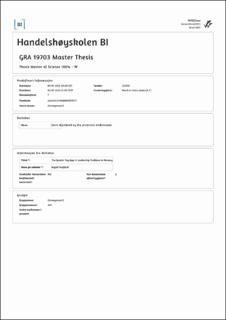The Gender Pay Gap in Leadership Positions in Norway
Master thesis
Permanent lenke
https://hdl.handle.net/11250/3100889Utgivelsesdato
2023Metadata
Vis full innførselSamlinger
- Master of Science [1621]
Sammendrag
Our hypothesis posits that the magnitude of the gender pay gap may be
exaggerated because such representations typically fail to account for individual
and group characteristics1. The escalating wage disparity with advancing age and
experience implies that the most substantial gender pay gaps are likely to occur in
leadership roles.
We use employee-employer data to compare women and men in the same firm
and occupation. We do not intend to establish any causal relationship between
gender and wage. Instead, our findings indicate a correlation between these
variables. Upon controlling for individual characteristics, the gender pay gap is
most pronounced in the private sector at 32.9%, compared to 21.6% in the public
sector. Introducing firm and occupational fixed effects reduces the gap to 13.5%
and 7.7% in the private and public sectors. Thus, firm and occupational traits
explain 59.0% of the wage disparity in the private sector and 64.4% in the public
sector2. A significant part of the remaining annual wage variance is linked to
contracted hourly wages rather than contracted hours. Upon accounting for
individual characteristics, the annual wage difference among executives is 27.4%
in the private sector and 16.6% in the public sector. The gender pay gap in
leadership roles is smaller than among all workers, countering prior statistical
reports. Our research also finds a slight decrease in the gender pay gap between
2015 and 2020.
Our results substantiate the fact that there is a gender pay gap but also amplify
that a large part of it is due to firm and occupational characteristics. While it is
well-documented that more women work part-time, this discrepancy becomes
minimal once group characteristics are considered. Simultaneously, our findings
indicate that the widest gender pay gap is observed among all workers rather than
specifically among leadership roles. Compared to broader statistics, this wage
discrepancy could be attributed to our modifications and controls for individual
and group characteristics.
Beskrivelse
Masteroppgave(MSc) in Master of Science in Business, Economics - Handelshøyskolen BI, 2023
